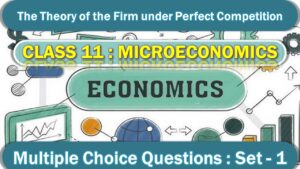CBSE Class 12 Magnetism and Matter Multiple Choice Questions with Answers. MCQ Questions Class 12 Magnetism and Matter with Answers Is Prepared Based on Latest Exam Pattern. Students can solve NCERT Class 12 Magnetism and Matter MCQs with Answers to know their preparation level.
Students who are searching for NCERT MCQ Questions for Class 12 Magnetism and Matter with Answers are compiled here to get good practice on all fundamentals. Know your preparation level on MCQ Questions for Class 12 Magnetism and Matter with Answers. You can also verify your answers from our provided MCQ Class 12 Magnetism and Matter with Answers. So, ace up your preparation with MCQ of Class 12 Physics Examinations.
MCQ Questions Class 12 Magnetism and Matter with Answers - Set - 5
Question 1:
Magnetic lines of force due to a bar magnet do not intersect because
(a) a point always has a single net magnetic field
(b) the lines have similar charges and so repel each other
(c) the lines always diverge from a single force
(d) the lines need magnetic lenses to be made to interest
Correct Answer – (A)
Question 2 :
Electromagnets are made of soft iron because soft iron has
(a) low retentivity and high coercive force
(b) high retentivity and high coercive force
(c) low retentivity and low coercive force
(d) high retentivity and low coercive force
Correct Answer – (C)
Question 3 :
Curie temperature is the temperature above which
(a) a ferromagnetic material becomes paramagnetic
(b) a paramagnetic material becomes diamagnetic
(c) a ferromagnetic material becomes diamagnetic
(d) a paramagnetic material becomes ferromagnetic
Correct Answer – (A)
Question 4 :
Liquid oxygen remains suspended between two pole forces of a magnet because it is :
(a) diamagnetic
(b) paramagnetic
(c) ferromagnetic
(d) antiferromagnetic
Correct Answer – (B)
Question 5 :
The magnetic susceptibility is negative for
(a) ferromagnetic material only
(b) paramagnetic and ferromagnetic materials
(c) diamagnetic material only
(d) paramagnetic material only
Correct Answer – (C)
MCQ Questions Class 12 Magnetism and Matter with Answers
Question 6 :
The materials suitable for making electromagnets should have
(a) high retentivity and low coercivity
(b) low retentivity and low coercivity
(c) high retentivity and high coercivity
(d) low retentivity and high coercivity
Correct Answer – (B)
Question 7 :
For protecting a sensitive equipment from the external magnetic field, it should be
(a) surrounded with fine copper sheet
(b) placed inside an iron can
(c) wrapped with insulation around it when passing current through it
(d) placed inside an aluminium can
Correct Answer – (B)
Question 8 :
A magnet makes 40 oscillation per minute at a place having magnetic intensity of 0.1 × 10–5 tesla. At another place it takes 2.5 sec to complete one oscillation. The value of earth’s horizontal field at that place is
(a) 0.76 × 10–6 tesla
(b) 0.18 × 10–6 tesla
(c) 0.09 × 10–6 tesla
(d) 0.36 × 10–6 tesla
Correct Answer – (D)
Question 9 :
There are four light-weight-rod samples A, B, C, D separately suspended by threads. A bar magnet is slowly brought near each sample and the following observations are noted
(i) A is feebly repelled
(ii) B is feebly attracted
(iii) C is strongly attracted
(iv) D remains unaffected
Which one of the following is true?
(a) B is of a paramagnetic material
(b) C is of a diamagnetic material
(c) D is of a ferromagnetic material
(d) A is of a non-magnetic material
Correct Answer – (A)
Question 10 :
What happens, when a magnetic substance is heated ?
(a) It loses its magnetism
(b) It becomes a strong magnet
(c) Does not effect the magnetism
(d) Either (b) and (c)
Correct Answer – (A)
- NCERT Solutions Class 11 Chemistry Chapter 1 : Some Basic Concepts of Chemistry
- NCERT Solutions Class 11 Chemistry Chapter 2 : Structure Of The Atom
- NCERT Solutions Class 11 Chemistry Chapter 3 : Classification of Elements and Periodicity in Properties
- NCERT Solutions Class 11 Chemistry Chapter 4 : Chemical Bonding and Molecular Structure
- NCERT Solutions Class 11 Chemistry Chapter 5 : States of Matter
- NCERT Solutions Class 11 Chemistry Chapter 6 : Thermodynamics
- NCERT Solutions Class 11 Chemistry Chapter 7 : Equilibrium
- NCERT Solutions Class 11 Chemistry Chapter 8 : Redox Reactions
- NCERT Solutions Class 11 Chemistry Chapter 9 : Hydrogen
- NCERT Solutions Class 11 Chemistry Chapter 10 : The s-Block Elements
- NCERT Solutions Class 11 Chemistry Chapter 11 : The p-Block Elements
- NCERT Solutions Class 11 Chemistry Chapter 12 : Organic Chemistry: Some Basic Principles and Techniques
- NCERT Solutions Class 11 Chemistry Chapter 13 : Hydrocarbons
- NCERT Solutions Class 11 Chemistry Chapter 14 : Environmental Chemistry




